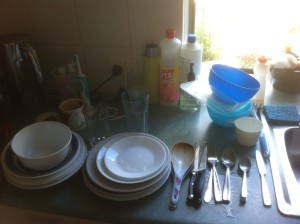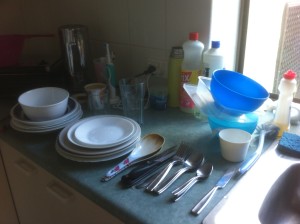
A while back, a visitor to our home laughed when he came into the kitchen and saw me preparing to do the dishes. He then asked me why I sorted the dishes so meticulously before washing them. “How come you don’t just chuck ’em all in the sink like I do?”
Well, let me explain. I think it is probably related to my Autism.
I started washing dishes standing on the little green kindy chair at the kitchen sink in Terang when I was about five years old. My mother, whom I suspect also may be Asperger’s Syndrome, used to stack the dishes very neatly for washing, everything lined up and in order.
The small bowls nestled within the larger bowls, so these were the ones you washed first. (the glasses and cups were actually washed before the larger dishes, but these are stacked at the back – so they cannot accidentally be knocked off the bench). When you placed bowls and plates on the cups (or, later on in life, in the dishrack) to dry, the small ones again nestled within the larger ones even though they were now all upside down and tilted.
Similarly, the plates were invariably placed beside the sink with the largest ones at the bottom of the stack, the medium ones in between and the smaller “bread and butter” plates near the top, followed finally by the saucers. Then the saucers are washed first, the bread and butter plates next and so on up to the dinner plates and, if present, the large serving platter. This is how it should be. To me, this is just the correct way.
But since then I have lived with a multitude of people during the intervening 63 years, and almost all of them seem to have no concept of the “only correct” way to stack the dishes. Bowls in jumbled order, plates interleaved amongst the bowls, large items on top of small items. You name it, they break the rules!
I have also usually sorted out the cutlery before beginning the dishwashing. For the “normal” cutlery, I start at the left with the soup spoons all stacked neatly in a single stack followed by the desert spoons stacked similarly. Next are the larger dinner forks followed by the smaller desert forks. To the right of the two stacks of forks, the teaspoons are stacked neatly and to their right the stainless-steel knives are placed neatly. Sometimes, the order of the stacks may vary, but the order of the washing of them does not. The knives, of course, are absolutely unstackable due to the predominantly ovoid cross section of their handles.
Then there are all the other odds and ends. About 20 to 40 cm to the left of the soup spoons, I start with any plastic serving spoons or ladles and the wooden spoons with the chopsticks neatly placed to their right. Next are any potato peelers, skewers, pizza cutting wheels, serving tongs, along with any other nondescript items that might have been used during the preparation or consumption of the meal. Between these and the soup spoons are any sharp carving knives, bread knives, steak knives, or fruit knives along with any other miscellaneous sharps.
The exact order of each of these stacks is actually quite important to me, as it relates precisely to where they will be later in the washing, drying and putting away process. Of course, not all of these items are present after each meal! More recently, I have begun to vary the order of the stacks, simply because I do not always have to work from right to left, and also because my daughter will often be washing them anyway and the order does not seem to matter as much to her, even though she also is an Aspie!
We have a stainless steel cutlery draining device in the shape of a truncated cone which stands on the bench behind the sink to the right of the taps. This is like a colander, in that it has holes all over its surface. The cutlery will fit in best if it goes in teaspoons first, then small forks, then larger forks, then dessert spoons, then soup spoons. All of these are placed working side downermost with handles uppermost in neat stacks according to types. Now the stainless steel knives go in pointed ends down and handles up in two stacks, bread and butter knives to the right and dinner knives to the left behind all the other cutlery.
Next the sharps are all done one at a time and placed in the drainer with the sharp ends down. The sharps are always handled individually since these are never to be placed in a heap out of sight under the suds in the sink. I was taught that method for safety reasons 63 years ago, and I never vary from it. Finally all the odd chopsticks and serving spoons, ladles etc. are placed smallest end first into the cutlery drainer or the side of the dishrack.
When the cutlery is being dried and put away, I open the odds and ends drawer first and work in order through all the ladles, chopsticks and whatever else belongs in that drawer. It is all at the top of the cutlery drainer. Next all the sharps are dried and put in their place at the left side of the top drawer. Then all the dinner knives followed by the bread and butter knives; then the soup spoons and the dessert spoons, followed by the dinner forks and dessert forks. Last of all, the teaspoons end up in their smaller slot in the cutlery drawer.
So you see that the correct stacking of the cutlery on the sink before washing is determined by where they will end up after they have been dried and put away. It all seems very logical to me. Why everyone else has to criticise the way I do the dishes is incomprehensible to me. I always tell anyone who does that if they don’t like the way I do it, then they are welcome to do it their way, even though I know it is the wrong way.

The same ordering of things into each item’s “correct” place has always been evident in just about anything I do in life. The tools I use for working on the motorbike are all in their correct place and if anyone else borrows one and puts it back on the wrong shelf in the shed, it can take me ages to find it.
I always park the motor mower behind the motorbike in the shed, because the bike will be used more frequently than the mower. Thus, while I am mowing the lawns, the motorbike is always out in the yard instead of in the shed!
I just think there is a logical order for everything.